The Orphanage, Charlestown of Aberlour, Strathspey, Morayshire, Scotland
The Aberlour Orphanage was established in 1875 at Charlestown of Aberlour, Strathspey. Its owed its existence to Miss Macpherson Grant of Aberlour who promised to fund the construction of the home, complete with its own school, church and rectory, if the Rev. Canon Charles Jupp — a man with a particular interest in the care of orphaned and abandoned children — would agree to become her personal chaplain.
The Orphanage's first premises were at Burnside Cottage, formerly a Dame's School run by a Miss Menzies. Here, on March 4th 1875, four 'mitherless bairns' were given a home. Construction of the permanent premises was initiated beginning with the church, which was designed by Alexander Ross and dedicated to St Margaret. However, the project received a setback when Miss Macpherson suddenly died in 1877. In 1882, the future of the Orphanage was secured following a legacy of £8,000 from Mr W Grant of Wester Elchies. The gift enabled the church to be completed and an enlarged scheme for the Orphanage to be undertaken at Campbell's Park, Aberlour.
The location of the home is shown on the 1902 map below.
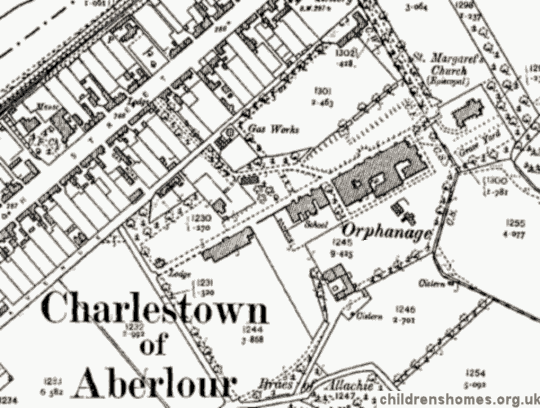
Aberlour Orphanage site, Strathspey, c.1902.
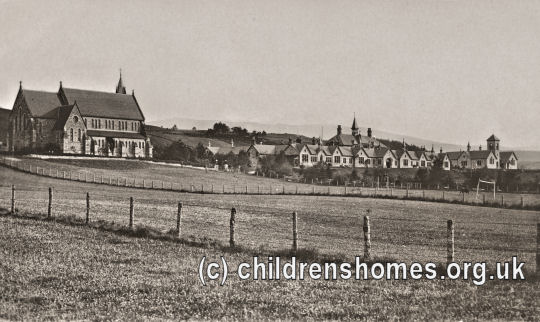
St Margaret's Church and Aberlour Orphanage from the north. © Peter Higginbotham
The main Orphanage building comprised a boys' wing at the west and a girls' wing at the east, with a school block at the centre. The accommodation was gradually extended and other facilities added including an infirmary, laundry, nurseries, farm, and a swimming pool. The number of inmates eventually rose to around 600, making Aberlour one of the largest children's establishments in Scotland, second on to the Quarrier's Homes.
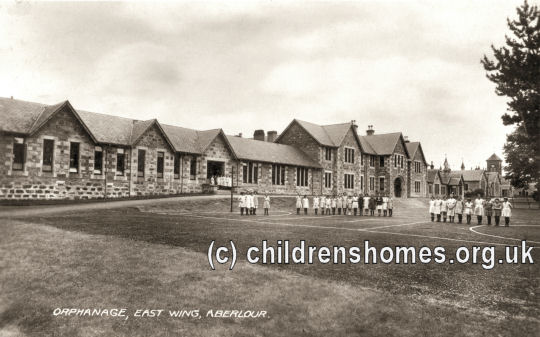
Aberlour Orphanage East Wing from the north-east. © Peter Higginbotham
The Orphanage took orphans and destitute children of any age and from England and Wales as well as Scotland. Although it was originally intended to restrict admission just to children from Episcopalian families, it broadened its intake to all religious denominations. Depending on the circumstances of each case, a payment could be required or free admission could be granted. Girls were primarily trained for employment in domestic service or other useful employment, and boys 'for whatever suited'. Children with scholastic ability could be put forward for higher education. Otherwise, those leaving the home were found work with employers who had been vetted and their progress recorded.
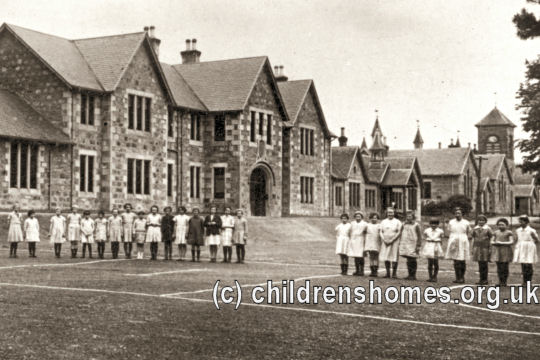
Aberlour Orphanage East Wing (detail) from the north-east. © Peter Higginbotham
The Rev. Jupp, as well as being Warden of the home, was the charity's Treasurer. He was a tireless fund-raiser and was affectionately known as the 'Beggar of the North', travelling far and wide to preach and appeal for support for the orphanage. In 1885, he began holding an annual jumble sale in the village. Jupp's Sales, as they became known, attracted shoppers from across the north of Scotland and raised thousands of pounds for the Orphanage. Despite his efforts, the institution was £3,000 in debt in 1890, leading to collections being taken in all the churches in Scotland and a theatrical entertainment organised in London by the Duke of Newcastle. After Jupp's death in 1911, his successor, the Rev. Walter Jenks, decreed that the recently completed boys' wing of the Orphanage should be named in Jupp's memory. In 1928, the Rev. Clarence Albert Wolfe (affectionately known as 'Wolfie') took over as Warden.
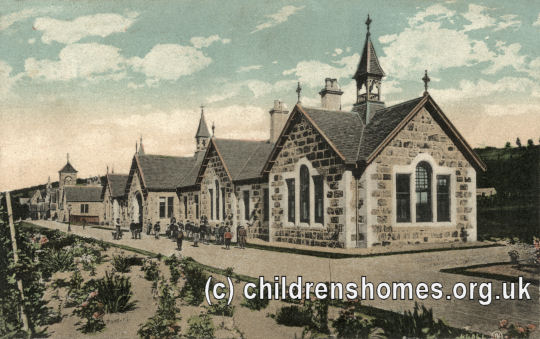
Aberlour Orphanage West Wing from the west. © Peter Higginbotham
The Orphanage received a visit from King Edward VII on September 23rd, 1907, and another from King George V and Queen Mary on August 21st, 1922.
Up until 1935, children at the home had an annual outing to the seaside at Lossiemouth. A children's holiday home was then established in a property further along the coast at Hopeman.
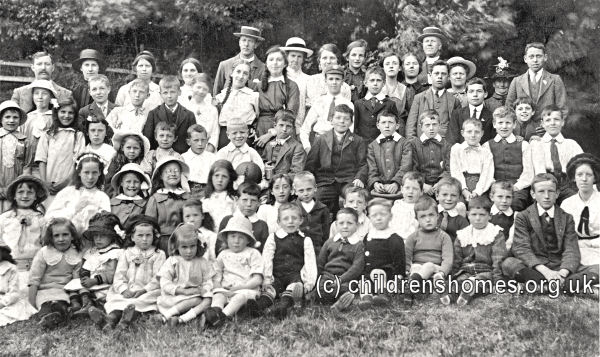
Aberlour Orphanage picnic, August 1912. © Peter Higginbotham
Over the years, there were several major fires at the Orphanage On Saturday June 13th, 1931, almost all of the east block was destroyed, with the cost of the damage estimated at around £20,000. The children were all out at the time and there were no casualties. On September 4th, 1937, again a Saturday, practically the whole of the west block was destroyed in a blaze of similar proportions which left 200 boys taking up temporary residence in the school rooms. Following a major fund-raising campaign, the boys' wing was rebuilt and re-opened in 1939 at a cost of £30,000.
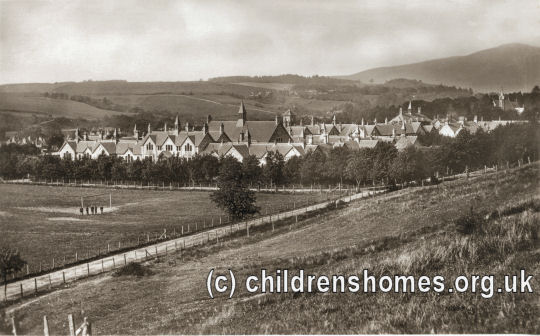
Aberlour Orphanage from the south-west, c.1950s. © Peter Higginbotham
In 1950, the Orphanage purchased the Allachie (or Allochy) estate at the south-west of Aberlour and converted its mansion house, The Dowans, into the Princess Margaret Nursery School. The nursery, housing 24 toddlers aged from two to five years, was formally opened by the Princess on 29 August 1953.
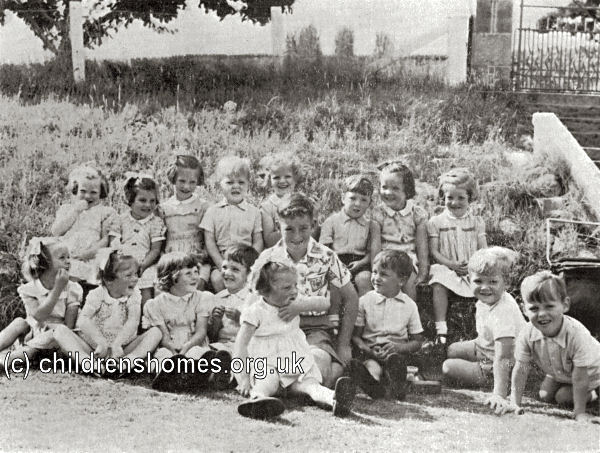
Aberlour Orphanage, Princess Margaret Nursery School, 1950s. © Peter Higginbotham
In 1958, after thirty years as Warden, the Rev. Wolfe retired and was succeeded by the Rev. CW Leslie. During Leslie's tenure, however, Aberlour fell in with the changing trend in child care and small 'family group' homes were gradually established in a number of Scottish towns and cities:
- 23 (later 21) Rubislaw Den North, Aberdeen
- 311 Clifton Road, Aberdeen
- 69 Constitution Street, Aberdeen
- The Neuk, Forsyth Street, Aberdeen
- 1 Seaview Road, Bridge of Don
- 26 Netherhills Avenue, Bucksburn
- 30 Quarryhill, Keith
- 152 McGregor Road, Cumbernauld
- Franklin House, 6 Bellyeoman Road, Dunfermline
- Sycamore Cottage, 44 Whytemans Brae, Kirkcaldy
- 31A Comley Bank, Hamilton
- The Orphanage, Charlestown of Aberlour, Strathspey
- The Dowans, Charlestown of Aberlour, Strathspey
- 40 Lomond Crescent, Stirling
The Orphanage at Aberlour was steadily wound down and finally closed in 1967. In 1969, the charity moved to new headquarters in Stirling, with the role of Warden being replaced by the post of Aberlour Trust Director. Today, the Aberlour Child Care Trust is the largest solely Scottish children's charity, providing support and resources for vulnerable children, young people and their families
Following the closure of the Orphanage, the buildings were demolished except for the church which has recently been renovated. In 2002, a community memorial garden was established on the site of the Orphanage, incorporating the its old clock tower.
Records
Note: many repositories impose a closure period of up to 100 years for records identifying individuals. Before travelling a long distance, always check that the records you want to consult will be available.
- For access to personal records contact the Aberlour Child Care Trust
- Heatherbank Museum of Social Work (now part of Glasgow Calenonian University's Research Collections), Saltire Centre, Glasgow Caledonian University, Cowcaddens Road, Glasgow G4 0BA. Holds a variety of administrative (but not personal) records and other material from the Aberlour Orphanage c.1905-1974.
Census
Bibliography
- Haynes, Dorothy K Haste Ye Back (1973, Jarrold)
- Divine, Dvaid Growing Up in an Orphanage: Tales of Personal Resilience (2013, www.goodenoughcaring.com)
Links
- Aberlour - Scotland's Children's Charity
- This Is Your Life episode featuring 'Wolfie'.
- This Week episode featuring Aberlour Orphanage.
Except where indicated, this page () © Peter Higginbotham. Contents may not be reproduced without permission.


